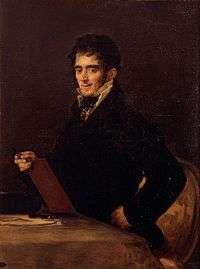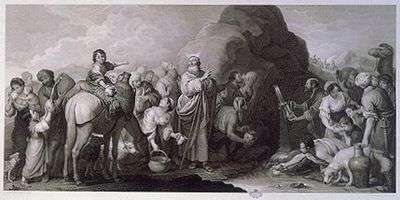Rafael Esteve
Rafael Esteve Vilella (1 July 1772, Valencia - 1 October 1847, Madrid) was a Spanish engraver in the Romantic style.


Biography
He was born to a family of artists. His father was the sculptor, José Esteve Bonet, and his uncle was the painter, Agustín Esteve. He received his initial artistic instruction at the Real Academia de Bellas Artes de San Carlos, in Valencia, then moved to Madrid, where he continued his studies at the Real Academia de Bellas Artes de San Fernando. During the reign of King Charles IV, he collaborated with the Royal chalcographers. In 1799, he was named the Court Engraver and executed portraits of the Royal Family, based on drawings made by his uncle, Agustín, after paintings by Francisco Goya; for the Guía de Forasteros (a type of almanac). This enabled him to begin a friendship with Goya, who painted his portrait in 1815. During the Peninsular War, he lived in Cádiz. Upon the war's completion, he was able to fulfill his desires to continue his education in France and Italy.
Among his most engravings are illustrations for the first sextodecimo edition of Don Quixote, prepared and edited at the Royal Printers from 1797 to 1798; the "Vista of the Teatro Seguntino, Taken from the Stands", after a drawing by Manuel Camaron i Melià, for Architectural and Antiquarian Travels in Spain (1807); and the portraits of Charles IV and Ferdinand VII and their respective spouses, José de Palafox with his officers, and posthumous depictions of Francisco Pizarro, Francisco Sánchez de las Brozas and Jerónimo Gracián, which he created for Portraits of Illustrious Spaniards.
In 1839, he received the greatest honor of his career in the form of a gold medal at the Exposition des produits de l'industrie française, for his burin etching of Moses Striking Water from a Rock; after a painting by Bartolomé Murillo, the execution of which involved living in Seville for a time.
He was also awarded a cross in the Order of Charles III and named Honorary Director of the Academia de San Carlos. He was also an "Academic of Merit" at the Academia de San Fernando and a corresponding member of the Paris Academy.
Sources
- Gallego Gallego, Antonio (1968). Historia del grabado en España. Madrid: Cátedra. ISBN 978-84-376-0209-7
- Zabala, Fernanda (2003). 125 valencianos en la Historia. Valencia (España): Carena Editors. ISBN 84-87398-64-2
- Catalá Gorgues, Miguel Ángel et al. (1986) El grabador Rafael Esteve. 1772-1847, exhibition catalog, Valencia, Publicaciones de la Fundación Caja de Pensiones ISBN 978-84-7664-049-4
External links
| Wikimedia Commons has media related to Rafael Esteve. |
- Digitalized works @ the Biblioteca Digital Hispánica of the Biblioteca Nacional de España